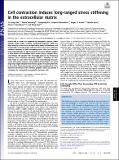| dc.contributor.author | Ronceray, Pierre | |
| dc.contributor.author | Lenz, Martin | |
| dc.contributor.author | Broedersz, Chase P. | |
| dc.contributor.author | han, yulong | |
| dc.contributor.author | Xu, Guoqiang | |
| dc.contributor.author | Guo, Ming | |
| dc.contributor.author | Malandrino, Andrea | |
| dc.contributor.author | Kamm, Roger Dale | |
| dc.date.accessioned | 2018-12-13T20:54:11Z | |
| dc.date.available | 2018-12-13T20:54:11Z | |
| dc.date.issued | 2018-03 | |
| dc.identifier.issn | 0027-8424 | |
| dc.identifier.issn | 1091-6490 | |
| dc.identifier.uri | http://hdl.handle.net/1721.1/119644 | |
| dc.description.abstract | Animal cells in tissues are supported by biopolymer matrices, which typically exhibit highly nonlinear mechanical properties. While the linear elasticity of the matrix can significantly impact cell mechanics and functionality, it remains largely unknown how cells, in turn, affect the nonlinear mechanics of their surrounding matrix. Here, we show that living contractile cells are able to generate a massive stiffness gradient in three distinct 3D extracellular matrix model systems: collagen, fibrin, and Matrigel. We decipher this remarkable behavior by introducing nonlinear stress inference microscopy (NSIM), a technique to infer stress fields in a 3D matrix from nonlinear microrheology measurements with optical tweezers. Using NSIM and simulations, we reveal large long-ranged cell-generated stresses capable of buckling filaments in the matrix. These stresses give rise to the large spatial extent of the observed cell-induced matrix stiffness gradient, which can provide a mechanism for mechanical communication between cells. | en_US |
| dc.description.sponsorship | National Cancer Institute (U.S.) (Grant 1U01CA202123) | en_US |
| dc.description.sponsorship | MIT-Germany Seed Fund | en_US |
| dc.description.sponsorship | Massachusetts Institute of Technology. Department of Mechanical Engineering | en_US |
| dc.publisher | Proceedings of the National Academy of Sciences | en_US |
| dc.relation.isversionof | http://dx.doi.org/10.1073/PNAS.1722619115 | en_US |
| dc.rights | Article is made available in accordance with the publisher's policy and may be subject to US copyright law. Please refer to the publisher's site for terms of use. | en_US |
| dc.source | PNAS | en_US |
| dc.title | Cell contraction induces long-ranged stress stiffening in the extracellular matrix | en_US |
| dc.type | Article | en_US |
| dc.identifier.citation | Han, Yu Long, Pierre Ronceray, Guoqiang Xu, Andrea Malandrino, Roger D. Kamm, Martin Lenz, Chase P. Broedersz, and Ming Guo. “Cell Contraction Induces Long-Ranged Stress Stiffening in the Extracellular Matrix.” Proceedings of the National Academy of Sciences 115, no. 16 (April 4, 2018): 4075–4080. © 2018 National Academy of Sciences | en_US |
| dc.contributor.department | Massachusetts Institute of Technology. Department of Mechanical Engineering | en_US |
| dc.contributor.mitauthor | han, yulong | |
| dc.contributor.mitauthor | Xu, Guoqiang | |
| dc.contributor.mitauthor | Guo, Ming | |
| dc.contributor.mitauthor | Malandrino, Andrea | |
| dc.contributor.mitauthor | Kamm, Roger Dale | |
| dc.relation.journal | Proceedings of the National Academy of Sciences | en_US |
| dc.eprint.version | Final published version | en_US |
| dc.type.uri | http://purl.org/eprint/type/JournalArticle | en_US |
| eprint.status | http://purl.org/eprint/status/PeerReviewed | en_US |
| dc.date.updated | 2018-12-04T15:45:26Z | |
| dspace.orderedauthors | Han, Yu Long; Ronceray, Pierre; Xu, Guoqiang; Malandrino, Andrea; Kamm, Roger D.; Lenz, Martin; Broedersz, Chase P.; Guo, Ming | en_US |
| dspace.embargo.terms | N | en_US |
| dc.identifier.orcid | https://orcid.org/0000-0002-9276-7772 | |
| dc.identifier.orcid | https://orcid.org/0000-0002-0016-4158 | |
| dc.identifier.orcid | https://orcid.org/0000-0002-7928-0951 | |
| dc.identifier.orcid | https://orcid.org/0000-0002-7232-304X | |
| mit.license | PUBLISHER_POLICY | en_US |
